International Journal of Image, Graphics and Signal Processing @ijigsp
Статьи журнала - International Journal of Image, Graphics and Signal Processing
Все статьи: 1157
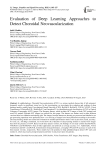
Evaluation of Deep Learning Approaches to Detect Choroidal Neovascularization
Статья научная
In ophthalmology, Choroidal Neovascularization (CNV) is a serious medical disease that, if left untreated, frequently results in significant vision loss. In this investigation, we investigate the evaluation and working of deep learning models, notably basic Convolutional Neural Networks (CNN), ResNet18, ResNet50, VGG16, VGG19, Vision Transformers, EfficientNetV2L, MobileNetV2 and InceptionV3 for identification and classification of CNV in Optical Coherence Tomography (OCT) images. The Kermany dataset, which includes OCT images of both CNV-patients and non-CNV patients (Normal OCT images) are utilized for this paper. The dataset was further used in three different versions based on validation and training split. The images from the dataset are already pre-processed and labelled so no pre-processing operations were performed, how- ever resizing of images have been performed according to the models. The deep learning models are trained and evaluated on standard performance metrics such as precision, recall, accuracy, F1-score, etc. All things considered, our work shows the evaluation of deep learning models to classify OCT images that show the presence of CNV. Based on all three dataset versions, the findings of our study confirm that ResNet18, VGGNet19, and MobileNetV2 beat all other approaches and achieved an average accuracy of 1. Additionally, Vision Transformer and Effi- cientNetV2L demonstrated strong performance, averaging 0.99 and 0.96 accuracy on each of the three dataset versions, respectively. These models have the potential to help ophthalmologists detect CNV early and monitor it, which may lead to prompt treatment and better vision preservation for patients.
Бесплатно
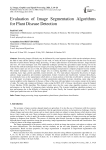
Evaluation of Image Segmentation Algorithms for Plant Disease Detection
Статья научная
Processing images efficiently may be influenced by some important factors which are the techniques chosen, the field of study and the quality of images. In this work, we study the field of agriculture with the focus on the early detection of plant diseases through image processing. To detect plant diseases such bacterial diseases, fungal diseases and virus, two main techniques exist: The traditional techniques provided by agricultural experts during visit on the field and the artificial techniques based on images processing algorithms. Since plantations are usually distant from the cities where experts are not easy to find, the artificial techniques incorporated in computer programs become suitable. The modern techniques used to analyse images rely on existing algorithms such as k-nearest neighbor, k-means clustering, fuzzy logic, genetic algorithm, neural networks, etc. Five main phases characterise the process of images analysis: image acquisition, pre-treatment, segmentation, feature extraction and classification. Amongst these phases, we particularly focus on the segmentation which allows to locate portions of leaf that are affected by a disease. Doing so, in this paper we propose a method to evaluate segmentation algorithms (k-means clustering, canny edge and k-nearest neighbor) on the diagnostic of diseases of three of the most cultivated plants (corn, potato, tomato) in the region of study. We study and compare performance values using the ROC-AUC of disease classification using the Support Vector Machine (SVM) algorithm. The obtained results show that the canny edge algorithm produces very poor performances on the family of solanaceae plants including potato. The k-nearest neighbour algorithm produces very poor performance due to the difficulty of choosing the k-value. Finally, the k-means algorithm makes it possible to obtain good prediction rates on all the chosen plants.
Бесплатно
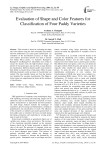
Evaluation of Shape and Color Features for Classification of Four Paddy Varieties
Статья научная
This research is aimed at evaluating the shape and color features using the most commonly used neural network architectures for cereal grain classification. An evaluation of the classification accuracy of shape and color features and neural network was done to classify four Paddy (Rice) grains, viz. Karjat-6, Ratnagiri-2, Ratnagiri-4 and Ratnagiri-24. Algorithms were written to extract the features from the high-resolution images of kernels of four grain types and use them as input features for classification. Different feature models were tested for their ability to classify these cereal grains. Effect of using different parameters on the accuracy of classification was studied. The most suitable feature set from the features was identified for accurate classification. The Shape-n-Color feature set outperformed in almost all the instances of classification.
Бесплатно
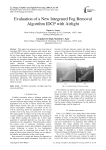
Evaluation of a New Integrated Fog Removal Algorithm IDCP with Airlight
Статья научная
This paper has proposed a new fog removal technique IDCP which will integrate dark channel prior with CLAHE and adaptive gamma correction to remove the fog from digital images. Fog in image reduces the visibility of the digital images. Poor visibility not only degrades the perceptual image quality but it also affects the performance of computer vision algorithms such as object detection, tracking, surveillance and segmentation.Various factors such as fog, mist and haze caused by the water droplets present in the air during bad weather leads to poor visibility. The proposed algorithm is designed and implemented in MATLAB using image processing toolbox. The comparison among Air-light and the proposed algorithm is also drawn based upon certain performance parameters. The comparison analysis has shown that the proposed algorithm has shown quite effective results.
Бесплатно
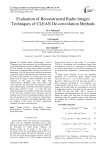
Evaluation of reconstructed radio images techniques of CLEAN de-convolution methods
Статья научная
In Modern Radio Interferometry Various Techniques have been developed for the Reconstruction of the high-dimensional Data scalability Radio Images. CLEAN Variants are widely used in Radio Astronomy because of its computationally efficiency and easiness to understand. CLEAN deconvolves different polarization component images independently and nonlinearly from the point source response by removing the dirty beam pattern form the images. CLEAN Algorithms have been evaluated in this paper for both single field "Deconvolution" (Hogbom, Clark, Clark Stokes, and Cotton Schwab) and multi-field "Deconvolution" (Multi Scale, Multi Frequency and Multi Scale Multi frequency). Based upon simulation results, it is clear that more updated techniques are needed for Large radio telescopes to face big data, extended sources emissions and fast imaging issues which are using dimensionality reduction from the perspective of the compressed sensing theory and to study its interplay with imaging algorithms which are designed in the context of convex optimization combined with sparse representations.
Бесплатно
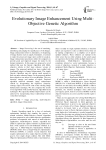
Evolutionary Image Enhancement Using Multi-Objective Genetic Algorithm
Статья научная
Image Processing is the art of examining, identifying and judging the significances of the Images. Image enhancement refers to attenuation, or sharpening, of image features such as edgels, boundaries, or contrast to make the processed image more useful for analysis. Image enhancement procedures utilize the computers to provide good and improved images for study by the human interpreters. In this paper we proposed a novel method that uses the Genetic Algorithm with Multi-objective criteria to find more enhance version of images. The proposed method has been verified with benchmark images in Image Enhancement. The simple Genetic Algorithm may not explore much enough to find out more enhanced image. In the proposed method three objectives are taken in to consideration. They are intensity, entropy and number of edgels. Proposed algorithm achieved automatic image enhancement criteria by incorporating the objectives (intensity, entropy, edges). We review some of the existing Image Enhancement technique. We also compared the results of our algorithms with another Genetic Algorithm based techniques. We expect that further improvements can be achieved by incorporating linear relationship between some other techniques.
Бесплатно

Exploring the Effect of Imaging Techniques Extension to PSO on Neural Networks
Статья научная
In this paper we go through some very recent imaging techniques that are inspired from space exploration. The advantages of these techniques are to help in searching space. To explore the effectiveness of these imaging techniques on search spaces, we consider the Particle Swarm Optimization algorithm and extend it using the imaging techniques to train multiple neural networks using several datasets for the purpose of classification. The techniques were used during the population initialization stage and during the main search. The performance of the techniques has been measured based on various experiments, these techniques have been evaluated against each other, and against the particle swarm optimization algorithm alone taking into account the classification accuracy and training runtime. The results show that the use of imaging techniques produces better results.
Бесплатно
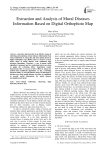
Extraction and Analysis of Mural Diseases Information Based on Digital Orthophoto Map
Статья научная
Currently, edge detection is an effective means of collecting and analyzing various diseases information from mural collections by using this and data mining based on digital orthophoto map (DOM). But it is hard to extract better edges of mural diseases with traditional edge detection algorithms. Therefore, a new K-means Sobel algorithm is proposed and two evaluation factors are given to judge the extracting effect. Experiment results demonstrate that we can get a better effect by using new method than traditional algorithms. At last, vectorizing detected results, we can gain diseases areas. On that basis, a decision tree about mural diseases severities is established to provide useful information for mural diseases investigation and repair.
Бесплатно
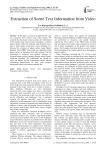
Extraction of Scene Text Information from Video
Статья научная
In this paper, we present an approach for scene text extraction from natural scene video frames. We assumed that the planar surface contains text information in the natural scene, based on this assumption, we detect planar surface within the disparity map obtained from a pair of video frames using stereo vision technique. It is followed by extraction of planar surface using Markov Random Field (MRF) with Graph cuts algorithm where planar surface is segmented from other regions. The text information is extracted from reduced reference i.e. extracted planar surface through filtering using Fourier-Laplacian algorithm. The experiments are carried out using our dataset and the experimental results indicate outstanding improvement in areas with complex background where conventional methods fail.
Бесплатно
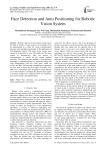
Face Detection and Auto Positioning for Robotic Vision System
Статья научная
Robotic vision system has taken a great leap in the field of robotics. Vision system is an essential tool to be implemented in a robot for visual communication between robot and human especially in the application of Tele-Diagnostic Robot. The robot vision system must always be in the field of view. The ability for the vision system to automatically track the person in communication is crucial for the remote medical specialist. To circumvent this problem, a face detection technique is implemented and it is performed using skin color segmentation with two color space which are YCbCr and HSV. Besides that, morphological operations are also done to detect the face region accurately. Two DOF servo mechanism were designed to ensure that the servo motor rotates to centralize the detected face region. A real-time testing were conducted and it was found that this system results a good performance.
Бесплатно
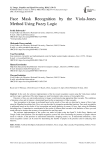
Face Mask Recognition by the Viola-Jones Method Using Fuzzy Logic
Статья научная
In the work, the software implementation of the face mask recognition system using the Viola-Jones method and fuzzy logic is performed. The initial images are read from digital video cameras or from graphic files. Detection of face, eye and mouth positions in images is performed using appropriate Haar cascades. The confidence of detecting a face and its features is determined based on the set parameters of Haar cascades. Face recognition in the image is performed based on the results of face and eye detection by means of fuzzy logic using the Mamdani knowledge base. Fuzzy sets are described by triangular membership functions. Face mask recognition is performed based on the results of face recognition and mouth detection by means of fuzzy logic using the Mamdani knowledge base. Comprehensive consideration of the results of different Haar cascades in the detection of face, eyes and mouth allowed to increase the accuracy of recognition face and face mask. The software implementation of the system was made in Python using the OpenCV, Scikit-Fuzzy libraries and Google Colab cloud platform. The developed recognition system will allow monitoring the presence of people without masks in vehicles, in the premises of educational institutions, shopping centers, etc. In educational institutions, a face mask recognition system can be useful for determining the number of people in the premises and for analyzing their behavior.
Бесплатно
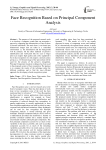
Face Recognition Based on Principal Component Analysis
Статья научная
The purpose of the proposed research work is to develop a computer system that can recognize a person by comparing the characteristics of face to those of known individuals. The main focus is on frontal two dimensional images that are taken in a controlled environment i.e. the illumination and the background will be constant. All the other methods of person's identification and verification like iris scan or finger print scan require high quality and costly equipment's but in face recognition we only require a normal camera giving us a 2-D frontal image of the person that will be used for the process of the person's recognition. Principal Component Analysis technique has been used in the proposed system of face recognition. The purpose is to compare the results of the technique under the different conditions and to find the most efficient approach for developing a facial recognition system
Бесплатно
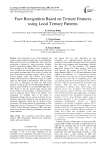
Face Recognition Based on Texture Features using Local Ternary Patterns
Статья научная
Face recognition is one of the important and popular visual recognition problem due to its challenging nature and its diverse set of applications. That's why face recognition is attracted by many researchers. Methods based on Local Binary Pattern (LBP) are widely used for face recognition in the literature, and it is sensitive to noise. To address this present paper utilized the powerful local texture descriptor that is less sensitive to noise and more discriminant in uniform regions called as Local Ternary Pattern (LTP). The Uniform Local Binary Pattern (ULBP) derived on LBP treats a large set of LBP under one label called as miscellaneous. This may result some loss of information on LBP and LTP based methods. To address this two Prominent LBP (PLBP) are derived, namely PLBP-Low (L) and PLBP-High (H) on LTP. Based on this the present paper derived eight texture features on facial images. A distance function is used on proposed texture features for effective face recognition. To eliminate most of the effects of illumination changes that are present in human face an efficient preprocessing method is used that preserves the significant appearance details that are needed for face recognition. The present method is experimented on Yale, Indian and American Telephone and Telegraph Company (AT&T) Olivetti Research Laboratory (ORL) data bases and it has given state-of-the-art performance on the three popular datasets.
Бесплатно
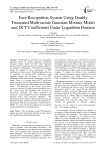
Статья научная
In this paper, we introduce a face recognition algorithm based on doubly truncated multivariate Gaussian mixture model with DCT under logarithm domain. In face recognition, the face image is subject to the variation of illumination. The effect of illumination cannot be avoided by mere consideration of DCT coefficients as feature vector. The illumination effect can be minimized by utilizing DCT coefficients under logarithm domain and discarding sum of the DCT coefficients which represents the illumination in the face image. Here, it is assumed that the DCT coefficients under logarithm domain after adjusting the illumination follow a doubly truncated multivariate Gaussian mixture model. The truncation on the feature vector has a significant influence in improving the recognition rate of the system using EM algorithm with K-means or hierarchical clustering, the model parameters are estimated. A face recognition system is developed under Bayesian frame using maximum likelihood. The performance of the system is demonstrated by using the databases namely, JNTUK and Yale and comparing it’s performance with the face recognition system based on GMM. It is observed that the proposed face recognition system outperforms the existing systems.
Бесплатно

Face Recognition System based on Convolution Neural Networks
Статья научная
Face Recognition plays a major role in the new modern information technology era for security purposes in biometric modalities and has still various challenges in many applications of computer vision systems. Consequently, it is a hot topic research area for both industrial and academic environments and was developed with many innovative ideas to improve accuracy and robustness. Therefore, this paper proposes a recognition system for facial images by using Deep learning strategies to detect a face, extract features, and recognize. The standard facial dataset, FEI is used to prove the effectiveness of the proposed system and compare it with the other previous research works, and the experiments are carried out for different detection methods. The results show that the improved accuracy and reduce time complexity can provide from this system, which is the advantage of the Convolution Neural Network (CNN) than other some of the previous works.
Бесплатно
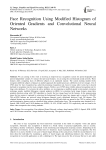
Face Recognition Using Modified Histogram of Oriented Gradients and Convolutional Neural Networks
Статья научная
We are aiming in this work to develop an improved face recognition system for person-dependent and person-independent variants. To extract relevant facial features, we are using the convolutional neural network. These features allow comparing faces of different subjects in an optimized manner. The system training module firstly recognizes different subjects of dataset, in another approach, the module processes a different set of new images. Use of CNN alone for face recognition has achieved promising recognition rate, however many other works have showed declined in recognition rate for many complex datasets. Further, use of CNN alone exhibits reduced recognition rate for large scale databases. To overcome the above problem, we are proposing a modified spatial texture pattern extraction technique namely modified Histogram oriented gradient (m-HOG) for extracting facial image features along three gradient directions along with CNN algorithm to classify the face image based on the features. In the preprocessing stage, the face region is captured by removing the background from the input face images and is resized to 100×100. The m-HOG features are retrieved using histogram channels evenly distributed between 0 and 180 degrees. The obtained features are resized as a matrix having dimension 66×198 and which are passed to the CNN to extract robust and discriminative features and are classified using softmax classification layer. The recognition rates obtained for L-Spacek, NIR, JAFFE and YALE database are 99.80%, 91.43%, 95.00% and 93.33% respectively and are found to be better when compared to the existing methods.
Бесплатно
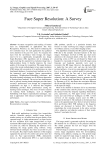
Face Super Resolution: A Survey
Статья научная
Accurate recognition and tracking of human faces are indispensable in applications like Face Recognition, Forensics, etc. The need for enhancing the low resolution faces for such applications has gathered more attention in the past few years. To recognize the faces from the surveillance video footage, the images need to be in a significantly recognizable size. Image Super-Resolution (SR) algorithms aid in enlarging or super-resolving the captured low-resolution image into a high-resolution frame. It thereby improves the visual quality of the image for recognition. This paper discusses some of the recent methodologies in face super-resolution (FSR) along with an analysis of its performance on some benchmark databases. Learning based methods are by far the immensely used technique. Sparse representation techniques, Neighborhood-Embedding techniques, and Bayesian learning techniques are all different approaches to learning based methods. The review here demonstrates that, in general, learning based techniques provides better accuracy/ performance even though the computational requirements are high. It is observed that Neighbor Embedding provides better performances among the learning based techniques. The focus of future research on learning based techniques, such as Neighbor Embedding with Sparse representation techniques, may lead to approaches with reduced complexity and better performance.
Бесплатно
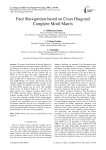
Face recognition based on cross diagonal complete motif matrix
Статья научная
To extract local features efficiently Jhanwar et al. proposed Motif Co-occurrence Matrix (MCM) [23] in the literature. The Motifs or Peano Scan Motifs (PSM) is derived only on a 2*2 grid. The PSM are derived by fixing the initial position and this has resulted only six PSM’s on the 2*2 grid. This paper extended this ap-proach by deriving Motifs on a 3*3 neighborhood. This paper divided the 3*3 neighborhood into cross and diag-onal neighborhoods of 2*2 pixels. And on this cross and diagonal neighborhood complete Motifs are derived. The complete Motifs are different from initial Motifs, where the initial PSM positions are not fixed. This complete Motifs results 24 different Motifs on a 2*2 gird. This paper derived cross diagonal complete Motifs matrix (CD-CMM) that has relative frequencies of cross and diagonal complete Motifs. The GLCM features are de-rived on cross diagonal complete Motifs texture matrix for efficient face recognition. The proposed CD-CMM is evaluated face recognition rate on four popular face recognition databases and the face recognition rate is compared with other popular local feature based methods. The experimental results indicate the efficacy of the proposed method over the other existing methods.
Бесплатно
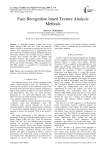
Face recognition based texture analysis methods
Статья научная
A unimodal biometric system based Local Binary Pattern (LBP) and Gray Level Co-occurrence Matrix (GLCM) is developed to recognize the facial of 40 subjects. The matching process is implemented using three classifiers: Euclidean distance, Manhattan distance, and Cosine distance. The maximum accuracy (100%) is satisfied when GLCM and LBP are applied with Euclidean distance. The accuracy result of these two methods is advanced the Principle Component Analysis (PCA) and Fourier Descriptors (FDs) recognition rate. The ORL database is considered for constructing the proposed biometric system.
Бесплатно
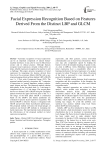
Facial Expression Recognition Based on Features Derived From the Distinct LBP and GLCM
Статья научная
Automatic recognition of facial expressions can be an important component of natural human-machine interfaces; it may also be used in behavioural science and in clinical practice. Although humans recognise facial expressions virtually without effort or delay, reliable expression recognition by machine is still a challenge. This paper, presents recognition of facial expression by integrating the features derived from Grey Level Co-occurrence Matrix (GLCM) with a new structural approach derived from distinct LBP’s (DLBP) ona 3 x 3 First order Compressed Image (FCI). The proposed method precisely recognizes the 7 categories of expressions i.e.: neutral, happiness, sadness, surprise, anger, disgust and fear. The proposed method contains three phases. In the first phase each 5 x 5 sub image is compressed into a 3 x 3 sub image. The second phase derives two distinct LBP’s (DLBP) using the Triangular patterns between the upper and lower parts of the 3 x 3 sub image. In the third phase GLCM is constructed based on the DLBP’s and feature parameters are evaluated for precise facial expression recognition. The derived DLBP is effective because it integrated with GLCM and provides better classification performance. The proposed method overcomes the disadvantages of statistical and formal LBP methods in estimating the facial expressions. The experimental results demonstrate the effectiveness of the proposed method on facial expression recognition.
Бесплатно

